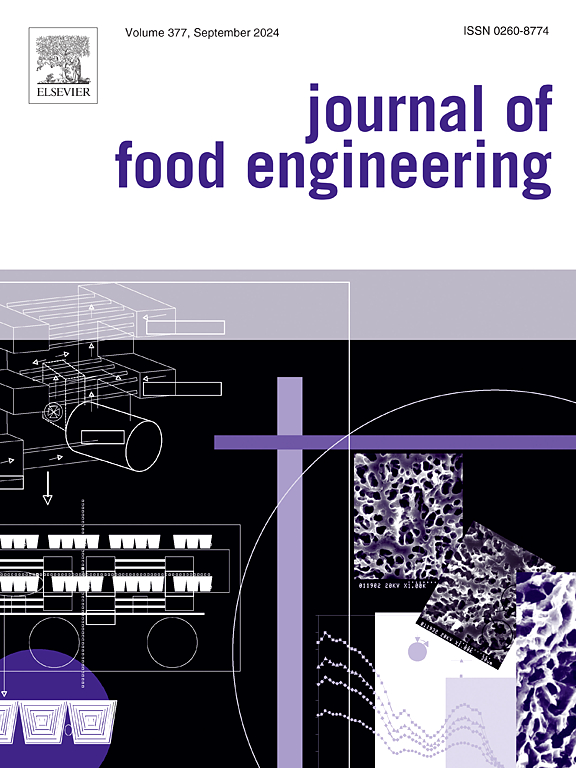油菜油状乳剂的冻融稳定性
IF 5.3
2区 农林科学
Q1 ENGINEERING, CHEMICAL
引用次数: 0
摘要
研究了天然油脂乳剂在冻融过程中的稳定性。采用碳酸氢钠(0.1 M)水溶液提取油菜籽中的油质体,将最终乳液的pH调整为9、6和3,使其表面电荷值分别为- 50.3±1.6、- 20.0±2.4和+37.5±0.5 mV。将脂质质量分数为0.28±0.02的乳剂冷却至- 20°C,持续24 h,并在20°C下解冻18 h,其冻融稳定性评估由于乳剂不稳定而定量释放油的量(油收率)。在- 20℃的等温保温条件下,pH值为9和6的油状乳剂的不稳定性随着保温时间的增加而增加,而pH值为3的油状乳剂的不稳定性更快。差示扫描量热法分析乳剂冷却从20°C在−−20°C 10°C /分钟,和举行−20°C 8 h,揭示了连续相迅速冷却结晶,而脂质结晶开始2 h后−20°C和持续了以下3 h。石油产量数据结合差示扫描量热法在pH曲线表明,油质体乳剂9和6稳定分散的脂质阶段的结晶,而在pH值为3时,乳剂随着连续相结晶而不稳定。假设在pH值为9和6时,脂质体乳状液是通过部分聚并机制破裂的。在pH值为3时,磷脂和油蛋白分子之间的静电相互作用可能减少,导致界面变弱,冷却时容易被冰晶破坏。连续相质量分数(0.50和0.70)增加的乳剂的产油率数据表明,不稳定程度低于对照组(0.28连续相)。将冻融循环次数从1次增加到3次并不会显著提高原油产量。本文章由计算机程序翻译,如有差异,请以英文原文为准。

Freeze-thaw stability of oilseed rape oleosome emulsions
This work investigated the stability of natural oleosome emulsions on freeze-thawing. Oleosomes were recovered from oilseed rape seeds following an aqueous extraction process using sodium bicarbonate (0.1 M). The final emulsions pH was adjusted to 9, 6 and 3 to achieve surface charge values of −50.3 ± 1.6, −20.0 ± 2.4, and +37.5 ± 0.5 mV, respectively. The emulsions with lipid mass fraction of 0.28 ± 0.02 were cooled to −20 °C for up to 24 h and thawed at 20 °C for 18 h, and their freeze-thaw stability assessed quantifying amount of released oil (oil yield) due to emulsion destabilisation. The destabilisation of the oleosome emulsions at pH 9 and 6 increased with isothermal holding time at −20 °C, whereas the emulsion at pH 3 destabilised more rapidly. Differential scanning calorimetry analysis of emulsions cooled from 20 °C to −20 °C at −10 °C/min, and held at −20 °C for 8h, revealed how the continuous phase rapidly crystallised on cooling, whereas lipid crystallisation started after 2 h at −20 °C and continued for the following 3 h. Oil yield data combined with differential scanning calorimetry curves suggest that the oleosome emulsions at pH 9 and 6 destabilised along with crystallisation of the dispersed lipid phase, whereas emulsions at pH 3 destabilised with the continuous phase crystallisation. It was hypothesised that oleosome emulsions at pH 9 and 6 ruptured by a mechanism of partial coalescence. At pH 3 the electrostatic interaction between phospholipids and oleosin molecules, the main components of oleosome interface, may be reduced resulting in a weaker interface which on cooling can be easily disrupted by ice crystals. Oil yield data for emulsions with increasing continuous phase mass fraction (0.50 and 0.70) suggest a lower extent of destabilisation than control (0.28 continuous phase). Increasing the number of freeze-thaw cycles from one to three did not cause significant increase in the oil yield.
求助全文
通过发布文献求助,成功后即可免费获取论文全文。
去求助
来源期刊

Journal of Food Engineering
工程技术-工程:化工
CiteScore
11.80
自引率
5.50%
发文量
275
审稿时长
24 days
期刊介绍:
The journal publishes original research and review papers on any subject at the interface between food and engineering, particularly those of relevance to industry, including:
Engineering properties of foods, food physics and physical chemistry; processing, measurement, control, packaging, storage and distribution; engineering aspects of the design and production of novel foods and of food service and catering; design and operation of food processes, plant and equipment; economics of food engineering, including the economics of alternative processes.
Accounts of food engineering achievements are of particular value.
 求助内容:
求助内容: 应助结果提醒方式:
应助结果提醒方式:


